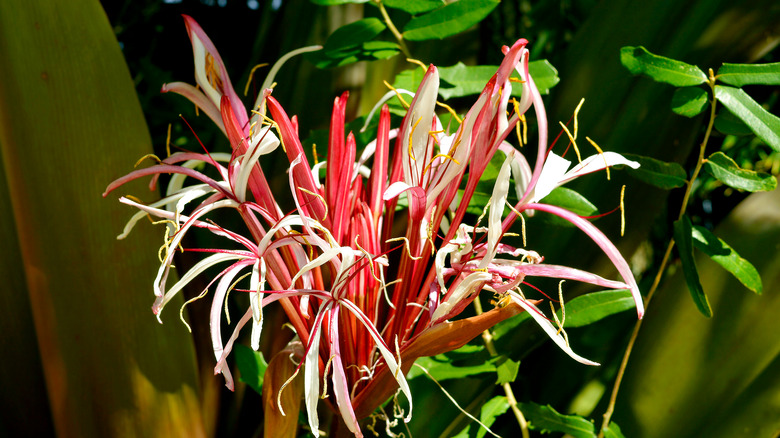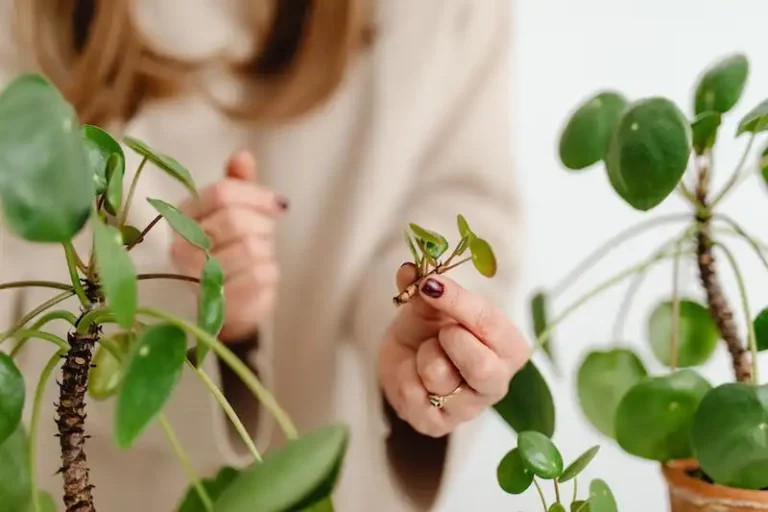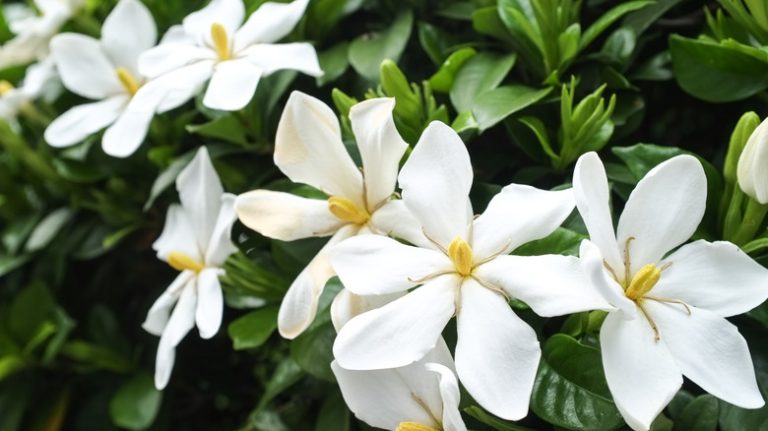Queen Emma is a variety of Crinum lily, scientifically known as Crinum augustum. Many things grow big in the tropics, and, according to the Chicago Botanic Garden, these Southeast Asia natives are no different: Their bulbs alone can weigh up to 20 lbs. each. Often called giant spider lilies, the richly scented flowers of Queen Emma have long stringy white and purplish-pink petals that burst out into a star shape. Some blooms have more reddish hues mixed in as well. The name Queen Emma is a dedication to the former ruler of the Hawaiian Islands, who was popular amongst the general public because of her humanitarian nature. She was also a plant lover.
Foliage on the Crinum augustum is just as big and bold as the showy blooms themselves. Each emerald and purple leaf can grow to a length of 36 inches, with the entire plant topping out at about 5 feet high and 3 feet around. They are truly exotic, and their tropical origins mean they are only hardy in USDA temperature zones 8 and higher. In those zones’ cooler regions, they will flower from spring to summer. In the hottest areas, however, they can constantly blossom year-round.
How to use Queen Emma lily in a garden

There’s no doubt a Crinum augustum will illuminate any garden or front yard landscape it’s placed into. The exoticness of the plant gives it a wild look, and since it has a moderate level of salt tolerance, it’s commonly used in coastal areas. The eye-catching blooms of the Queen Emma lily can be found all over South Florida, from business campuses to suburban homes and condominium complex landscapes. A single flourishing plant should be large enough to create a statement. You can also plant a few together if you have the space.
When working these mammoth plants into your yard, South Florida Plant Guide recommends leaving around 4 feet between individuals for multiple plantings. Keep your lily 5 feet away from any nearby shrubs that grow particularly large, and don’t forget to leave plenty of space between a bulb planting and a structure such as a garage or the wall of a house. Once they grow, your initially small plants will take up a few feet radius, likely more. Dig your holes set back from sidewalks as well to ensure they don’t claim the path over time. For a less wild, more structured design, line a driveway with the largest containers you can find and plant a single Queen Emma lily in each one.
How to grow a Queen Emma lily
Queen Emma Crinum lilies can be grown by seed or propagated by division when pups appear. Pups are the offshoots that grow up from the rootball, or bulb in the case of lilies, through asexual reproduction. Then, like babies, they will grow to become complete new plants on their own. Starting from seed is unreliable as well as time-consuming, but division is faster and much easier, so it’s the go-to method for most growers.
Gardening Know How recommends waiting for the slowest period of growth on any given plant to start the dividing process and do it only when you really need to. Make sure your clippers are clean and sharp, put on some gloves, and you’ll be ready to get to work. The first thing you’ll do is dig out the entire bulb from its hole. This may require you to use a trowel or spade. Just be gentle. Scrape away whatever soil you can without disturbing the roots. Then break a stalk away from the bulb and place your original plant back down in its pot covered in soil. You may need to use your cutters if the stalks are hard to break off. The goal is to end up with stalks with their own bulb with roots. These will be planted either in individual pots or in a different part of the yard. It can take up to three years to see flowers on your new plants.
How to care for a Queen Emma lily
Andrei Medvedev/Shutterstock
The Queen Emma lily is not about to surrender its life on earth due to a touch of drought or lack of attention. However, its light and moisture requirements are high, especially while they’re actively growing. This makes both frequent watering and full sun exposure necessities. Soggy ground is a no-no for most plants, but they like their soil moist. Epic Gardening even suggests planting them near a pond or other water feature. They’ll grow just about anywhere as long as they’re supplied with a dependable water source.
If you’re unsure about the nutrient health of the natural soil in your yard, add mulch and compost to increase fertility and aid in water retention. Slow-release granular fertilizer added once per season (except in winter) will help keep plants well-fed and blooming. Potted Crinum augustums need plenty of room for their large bulbs and deep root systems, so ensure you always choose a large container for them.
Generally speaking, you should not need to prune a Queen Emma lily beyond removing dead flowers. The long stems of lilies are called scapes, and each one can produce 20 flowers. If you want to cut your plant back for size, wait until a scape is finished flowering, then trim it back to the neck of the bulb where it comes out of the ground. The next scape will shoot up from the same spot, and you can repeat the process as needed.
Queen Emma lily varieties
matkub2499/Shutterstock
The Crinum genus contains 130 species of lily, many of them tougher hybrids with a more trumpet-like shape. Throughout the southern region of the U.S. — where they’re most popular due to appropriate temperature zones and have been cultivated through generations — Crinum lilies are relied upon for their unbelievable hardiness and general aversion to death and dying. So much so that an East Texas horticulturist named Greg Grant calls them pretty darned eternal due to stories of them popping back up out of the ground after repeated pesticide dousings and even being run over by lawnmowers. Per Southern Living, these flowers are colloquially called hot country lilies down south. You’ll see them lining the drives of homesteads in shades of reds, pinks, purples, and white.
There are a few other similar options to choose from when it comes to the starburst shape of the more delicate Queen Emma lily.
- The Giant lily or Crinum asiaticum is the most common alternative to Queen Emma, per Gardenia. Its flowers are all white, and the foliage lacks any purple tints. Overall, the plant tends to be slightly more compact.
- The Crinum procerum var. splendens (pictured above) is a stunning fuchsia striped variation of the Queen Emma lily, Dave’s Garden notes. This flower tends to bloom in the fall, and it prefers full sun, extra moisture, and a tender touch. It also does well near a water feature like a garden pond or stream, but please, no lawnmowers!
Is the Queen Emma lily toxic?
Phillip B. Espinasse/Shutterstock
A gold dust gecko, seen above, may feel safe lounging the day away perched on a Queen Emma lily, but what about pets and children? The answer is not as straightforward as we might hope. Per the Food and Drug Association, all lilies are dangerous, particularly for cats, for whom its toxins can cause kidney failure, although the actual poison remains unidentified. More confusion comes when we take a closer look at classification. Species of the Crinum genus are often called lilies, even though they’re not technically true lilies. However, those belonging to the genus Lilium are considered lethal when consumed by felines. So if Crinums are not actual lilies, does that make them safe?
Unfortunately, one of the lesser-known nicknames of the Crinum augustum is poison bulb, coming from the belief that the plant is toxic and the bulb is the most poisonous part. While eating any part of the plant may cause mild symptoms in humans and dogs, cats and kidney failure are the main concerns once again. All that said, Pet Poison Hotline does not include Crinum augustum on its list of highly toxic plants. Neither does the ASPCA. Where do we go from here? At the end of the day, most cats are known to chew on plants. It’s a fact of life, and it may be the only reason you need to keep these guys out of your house and perhaps even out of your yard
How to repot your Queen Emma lily

Pixel-Shot/Shutterstock
Crinum lilies have enormous bulbs taking up quite a bit of space under the soil. When it’s time to repot, it’s also likely time to pull off some stalks for propagation by division. It’s possible that once you’ve removed a few of these stalks, you’ll find plenty of room left in your container to simply repot the original back into the same spot. It’s important to take this opportunity to freshen up the soil before doing so. As you get situated, remember that those bulbs can weigh as much as 20 lbs. Employ an extra set of hands if you’ll have trouble removing it by yourself, and wear gloves to avoid any potential skin irritation.
Organic Gardening offers a video tutorial on its YouTube channel for gently removing compact soil surrounding the roots and bulb. Start by digging the entire plant out, then pick away or shake off residual soil before dividing the stalks. Empty the container of the old nutrient-deficient soil and refill it with a fresh mix, including compost and other organic matter. You may also want to add that granular fertilizer if the timing is appropriate. Finally, leave enough space for the original bulb, cover it with more soil, water generously, and set aside. The offshoot pups that you removed are now ready for their new homes. Repeat the process above for each one in an individual pot.
The flower named for a queen

Heritage Images/Getty Images
Though not a native species to Hawaii, the Crinum augustum was named after Princess Emma Kalanikaumakaʻamano Kaleleonālani Naʻea Rooke. She became Queen Emma through her marriage to Prince Alexander Liholiho, who would later be known as King Kamehameha IV. Seen seated in the photograph above, Queen Emma was a beloved member of the royal house and devoted much of her life’s work to education and health care. Alongside her husband, she established Honolulu’s Queen’s Hospital. She was also an avid gardener, and the Crinum lily with green foliage and reddish flowers was believed to be her favorite.
Hawaii Horticulture, a blog about gardening and plants in Hawaii, tells the story of disagreeing botanists who, as of a 2024 article, continued to argue over precisely which Crinum lily variation was indeed named for the queen. A horticulturist at Hawaii’s Lyon Arboretum, along with botanist L.S. Hannibal, have declared the augustum was her preferred lily. Meanwhile, Peter Green of the National Botanical Garden and George Staples from the Bishop Museum claim that variety wouldn’t have yet existed in her time, making them certain it was actually the rather wispy Crinum pedunculatum, which can grow in various conditions, TopTropicals notes. We may never have the full story since Queen Emma passed away back in 1885 at the young age of 49, but we do know that the flowers are very similar to one another, and both are adored by humans worldwide.


